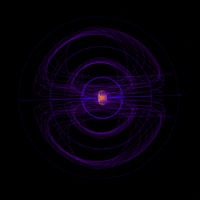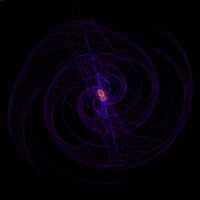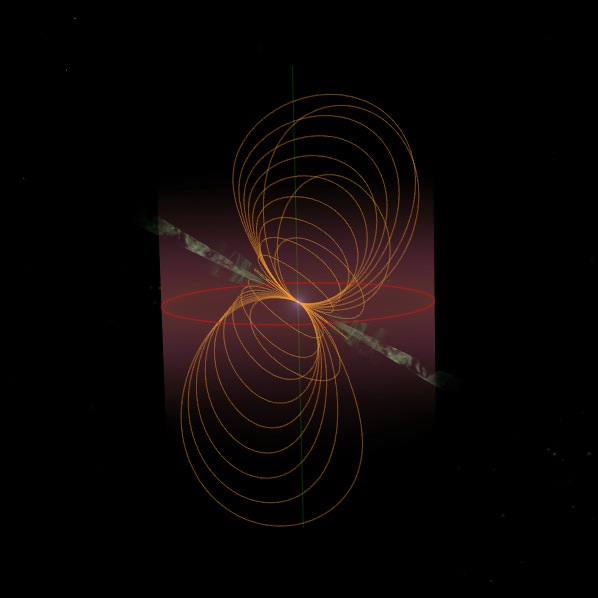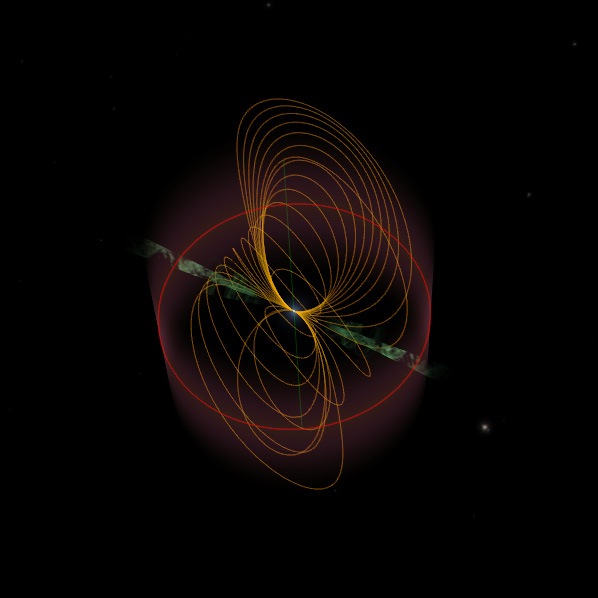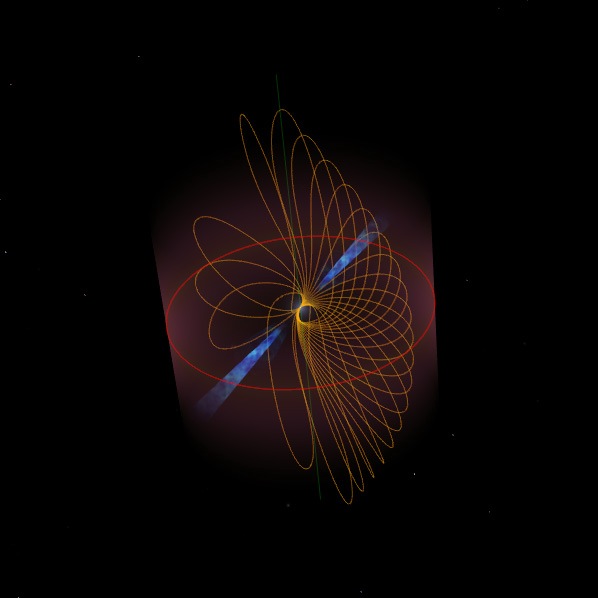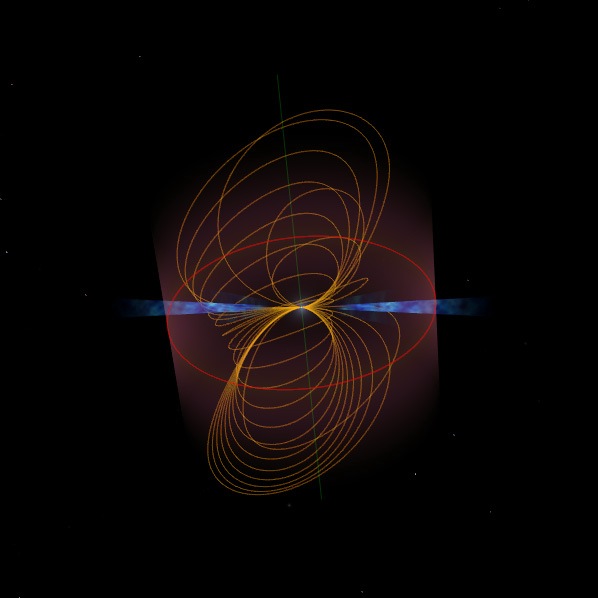Page 1 of 4
New magnetic field configurations (work in progress)
Posted: 30.12.2006, 21:59
by Cham
Posted: 31.12.2006, 10:29
by Fightspit
I know ! It is a .... cookie


Posted: 31.12.2006, 12:23
by PlutonianEmpire
nice slinky!

Posted: 31.12.2006, 19:51
by Cham
This is yet another pulsar model.
The blurry cylinder is called the "light cylinder" of the pulsar. It's an imaginary surface which divides space in two regions : the points inside are the locations of particles that could follow "rigidly" the pulsar's rotation with a velocity less than the speed of light. Outside the light cylinder, particles can't follow (rotate) at the same rate as the pulsar, or else they'll travel faster than light.
The curved lines (slinky shaped) are the "last closed magnetic field lines" of the pulsar. Because a plasma is a perfect conductor, the field lines are strongly distored outside the light cylinder and do not close (a plasma could sustain large electrical currents and generate magnetic field on its own). The outside field lines are open to the interstellar medium. The "last closed" lines also DEFINES the pulsar's polar caps by their "footprint" on the star's surface. Those caps are the two regions where particles could escape to inifinity, hence the formation of jets.
Those last closed lines are all tangent to the light cylinder.
There is really a lot of physics in this simple model. That's why I want to make some pulsar models for Celestia.
Posted: 04.01.2007, 08:59
by Cham
Posted: 04.01.2007, 23:01
by Cham
I've added some radiation field lines (blue curves), for the 90?° case. While in rotation in Celestia, we can clearly feel the flow out of electromagnetic radiation.

For an inclination less than 90?°, the radiation pattern is much more complicated and the model is getting confused. I'm not sure I'll continue on this track, especially since nobody seems to be interested in this stuff. I guess I should concentrate on SF models and eye candy textures

Posted: 05.01.2007, 16:36
by buggs_moran
Oh I don't know about that Cham. I find it very amazing that you are generating all of this. And it does have educational usefulness. Have you contacted the writer's of that paper? I'll bet you they and their colleagues would be very interested in the visualizations you have produced. I think these fields would be even more fantastic if they could be turned on and off at will. Please don't go SF, I think your talents are needed more in the realistic realm of Celestia.
Posted: 05.01.2007, 17:28
by ANDREA
Cham wrote:... I'm not sure I'll continue on this track, especially since nobody seems to be interested in this stuff. I guess I should concentrate on SF models and eye candy textures

I don't think you are right saying that nobody is interested in this stuff.
I use your work in my educational shows for Earth and pulsars, and I'm waiting the final results for this new implementation, that I find very interesting.
And I agree with Buggs, the staff of the paper will be very interested in your graphical application of their work.

Cham, don't leave your search on magnetic fields, please.
Bye.
Andrea

Posted: 06.01.2007, 07:58
by Cham
Thanks for the encouragements, guys.
I now have all the cases I wanted : inclination angle "alpha" = 30?° , 45?°, 60?° and 90?°. The "last closed" field lines models I have are exactly the same curves as presented in the Astrophysics paper I mentioned previously. I'm very happy with the results.
I'm now wondering about the time evolution of the field lines. Apparently, according to the equations and to some preliminary numerical resolutions in Mathematica, they are supposed to rotate like a rigid body. Since there are electromagnetic waves emitted and flowing out to infinity, I'm not yet convinced that the lines should rotate like a rigid body. If they are moving like an organic object (or like a fluid), there's no way I could show them evolving in Celestia. If they do rotate like a rigid body, then this will be great in Celestia.
I'm finding some very weird radiation patterns and field lines, like the blue curves shown on the picture below. I just can't believe they are really rotating like a solid. Seems very strange to me.
Fridger, do you think this is actually possible ?
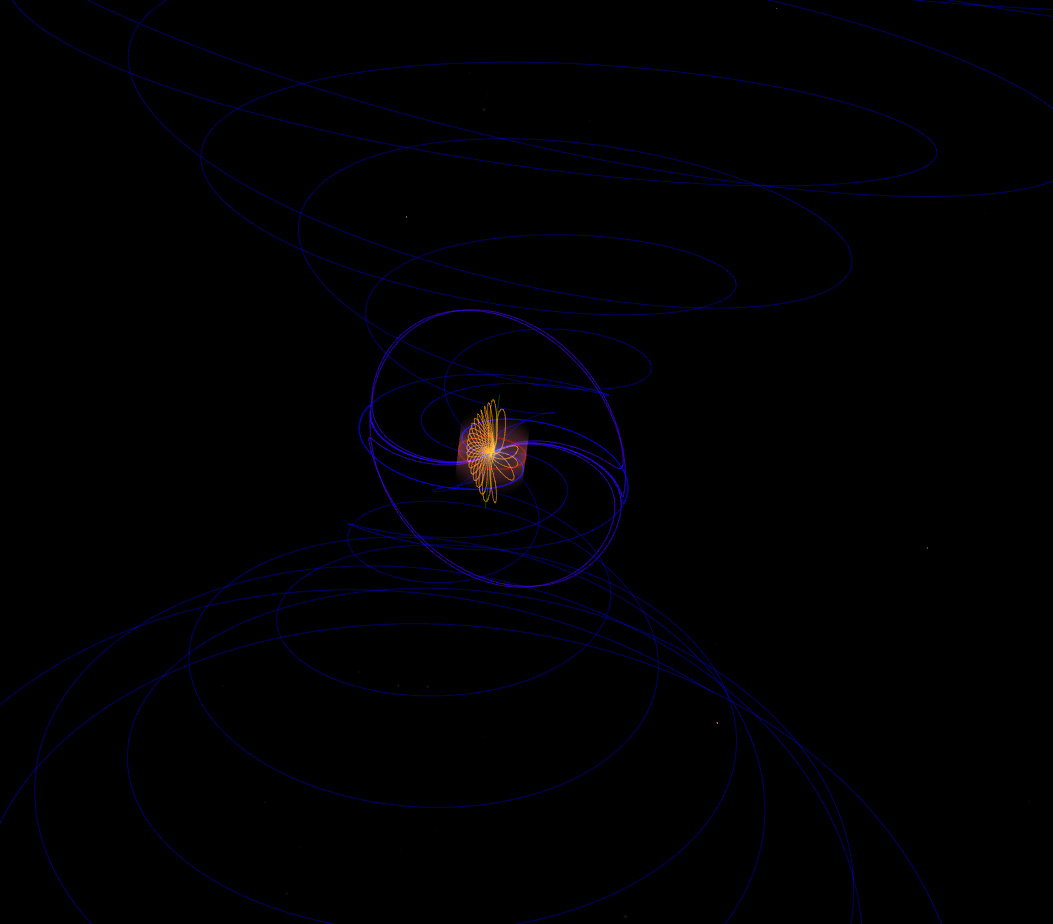
Posted: 06.01.2007, 09:23
by Cham
This large blue circle and the equatorial spiral are really puzzling me. Is this pattern really supposed to rotate like a rigid body ? This is really weird.
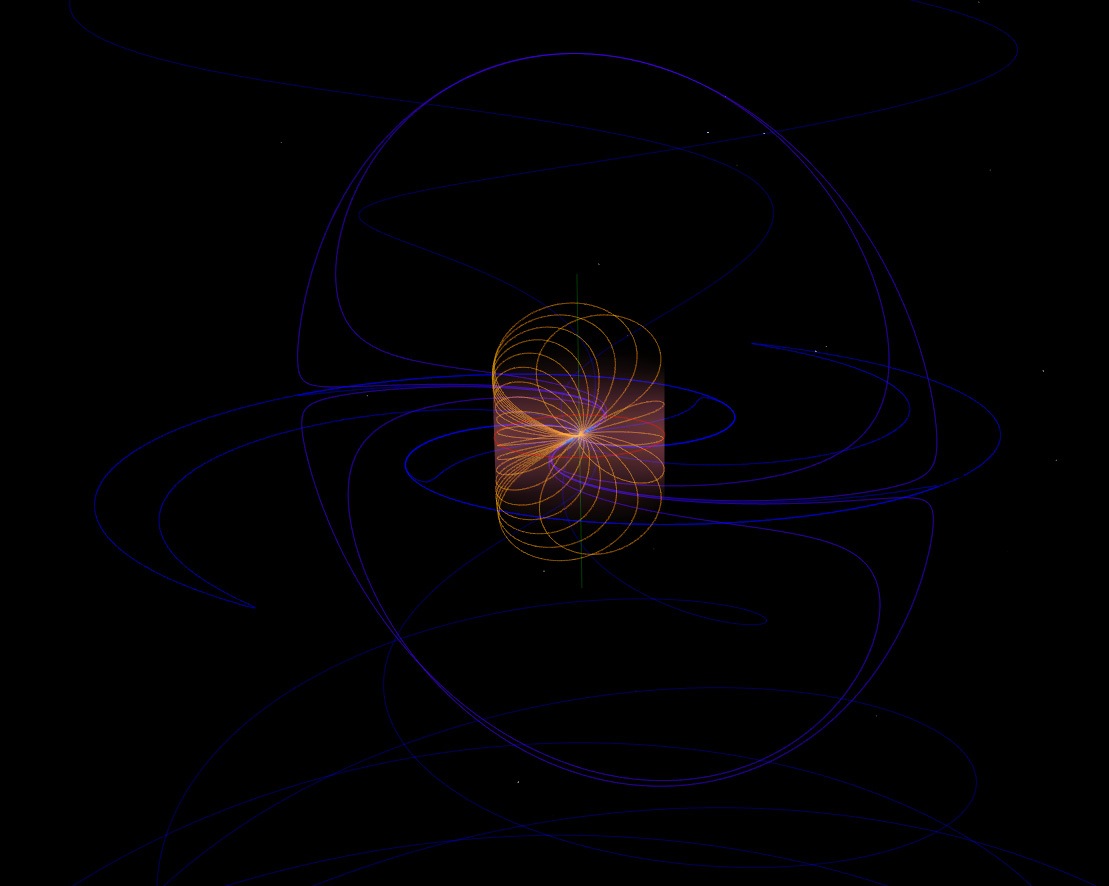
Posted: 06.01.2007, 12:13
by Boux
Cham wrote: ... I'm not sure I'll continue on this track, especially since nobody seems to be interested in this stuff. I guess I should concentrate on SF models and eye candy textures

Cham, your experiments are fascinating. Please do not give up!
Actually, your addons (Magnetic Earth and Pulsar models) are by far my favourites

I think this kind of work matches perfectly Celestia's purpose.
... and YES, it is also great eyecandy

Posted: 06.01.2007, 12:53
by selden
Since they propagate at the speed of light, magnetic fields can't rotate like a rigid body over large distances, although that's probably a reasonable approximation for small distances. I'm not sure what scale you're trying to represent. And, of course, relativistic effects confuse me, too.
Posted: 06.01.2007, 16:46
by Cham
selden wrote:Since they propagate at the speed of light, magnetic fields can't rotate like a rigid body over large distances, although that's probably a reasonable approximation for small distances. I'm not sure what scale you're trying to represent. And, of course, relativistic effects confuse me, too.
Selden,
yes, for all EM problems I know, field lines deforms in some "organic" way (like a fluid) as waves are emitted, because of the velocity of light limitation. However, in this special case, the source (an uniformly magnetized sphere) is steadily spinning since "the beginning of time" and there's apparently an hidden symetry. It's not like the waves emitted by a single particle moving on a circle. The spinning sphere may allow a rigid rotation like propagation of waves, but I'm still not sure of that possibility.
Posted: 07.01.2007, 01:41
by Cham
Things are getting weirder than ever ! The equations are okay and Mathematica is doing its job very well, so I don't think I'm making an error anywhere, and numerical precision isn't a concern here. Only the interpretation is lacking.
I really feel like some kind of explorer on an unknown continent, discovering strange creatures.
The red curve shown below is the limit of some kind of transition between field lines. If I change very slightly the starting point, it gives a new kind of curves familly, mostly open and wave like (transition from intermediate field to far zone radiation field, I guess). The part indicated in green is actually very smooth (the picture scale doesn't show what is actually happening there). There is no discontinuity, no lines crossing anywhere !
That red curve is actually four closed and non-crossing curves, starting at a polar cap and ending at the other one. Each one has about 20 thousand points. There's no impact on the frame rate. Everything is extremelly smooth.
It's becoming truelly spectacular, live in Celestia, all those curves in 3D with the ability to move in. It could be awesome to see those curves with some virtual reality immersion.
EDIT : since the time evolution is steady, I'm starting to believe those structures are actually standing waves of some sort. I evaluated the distance between both circles as about 9888 km, in Celestia. The wavelenght is 2Pi/k = 9893 km ! This supports the idea that there are some standing waves here and that the field lines do rotates like a rigid body.

Posted: 07.01.2007, 08:12
by Cham
This beast is really fascinating !
I'm now confident that these circular structures are indeed standing (stationnary) waves. Each circle is clearly separated by a wavelenght and there's an infinite set of those circles :

As seen from above, there's clearly a spiral structure which is associated to a wave flowing out :

What amazes me the most is that all these circular curves are actually closed : each curve is starting at a polar cap and ending at the other polar cap !
And there's a kind of mathematical conspiracy that prevent any line crossing (which is a well known feature of electromagnetic field lines) :
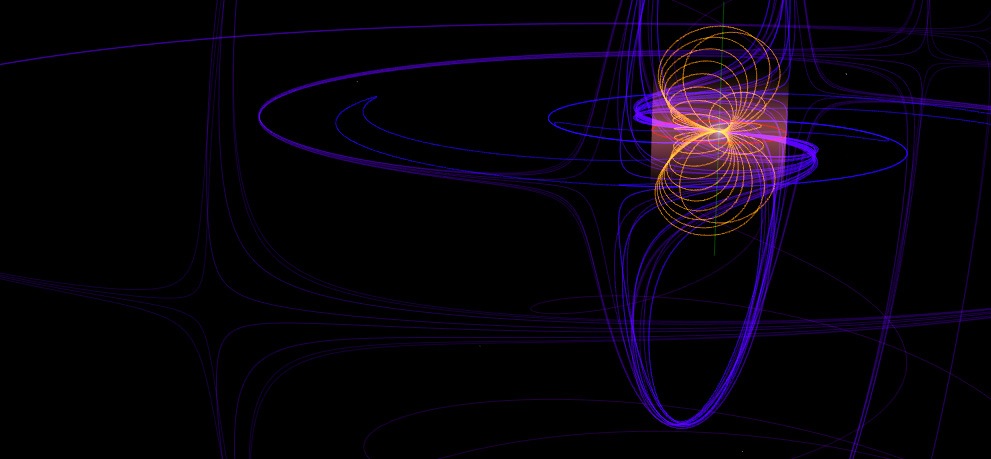
All these properties are showing that the field lines are indeed globally rotating like a rigid body ! The time evolution in Mathematica clearly shows this anyway. This feature is really amazing and could be exploited in Celestia.
Posted: 07.01.2007, 11:53
by Vincent
Cham,
All this looks really interesting. What about drawing your magnetic field lines directly in OpenGL, using the Lua commands ? This would require only a few lua files to be added in the extras folder. The rendering of magnetic filed lines could be toggled using one or several keys. You could also use several active buttons, each one for a specific wavelenght...
Hank has already implemented a Lua binding to 2D OpenGL functions. If you're interested in using Lua, I could add some basic 3D OpenGL commands to draw your magnetic lines. Just let me know...
Posted: 07.01.2007, 17:57
by selden
Whether or not Cham is interested, I know others are.
Posted: 08.01.2007, 04:42
by Cham
Here's an "experimental proof" (directly from Mathematica) that the lines do rotates like a rigid body. However, I simply don't understand that a magnetic field line can "precesse" like this, especially since this is from the
alpha = 90?° case.
http://nho.ohn.free.fr/celestia/Cham/Di ... tation.mp4 (tiny mp4 movie)
Here's another example (alpha = 90?° again) :
http://nho.ohn.free.fr/celestia/Cham/Divers/Dipole2.mp4 (tiny mp4 movie)
EDIT : Here's a better movie :
http://nho.ohn.free.fr/celestia/Cham/Di ... tation.avi
And here are two pictures of some magnetic field lines, clearly of radiation nature :
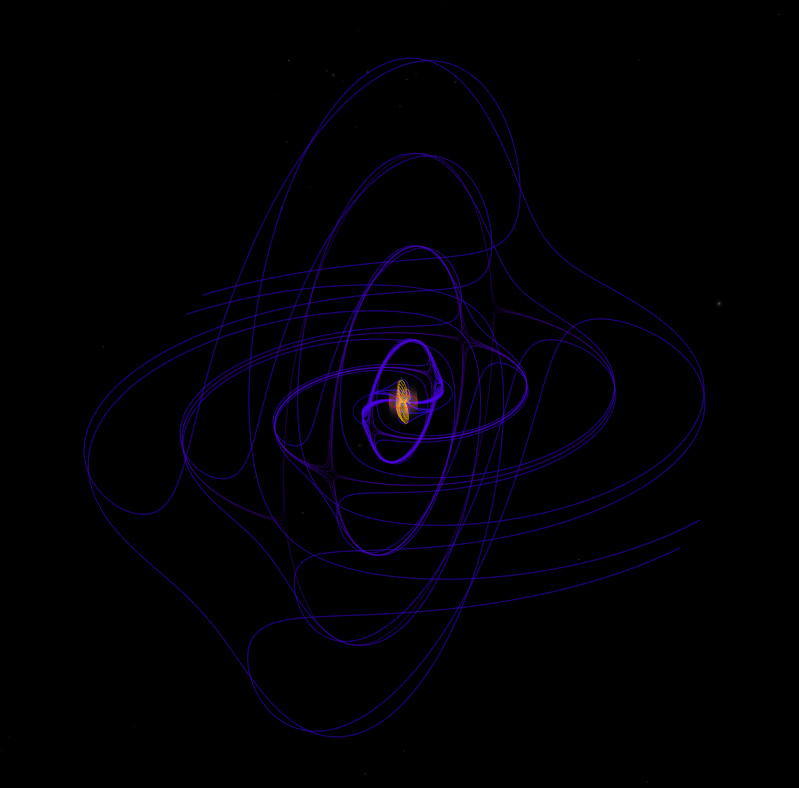
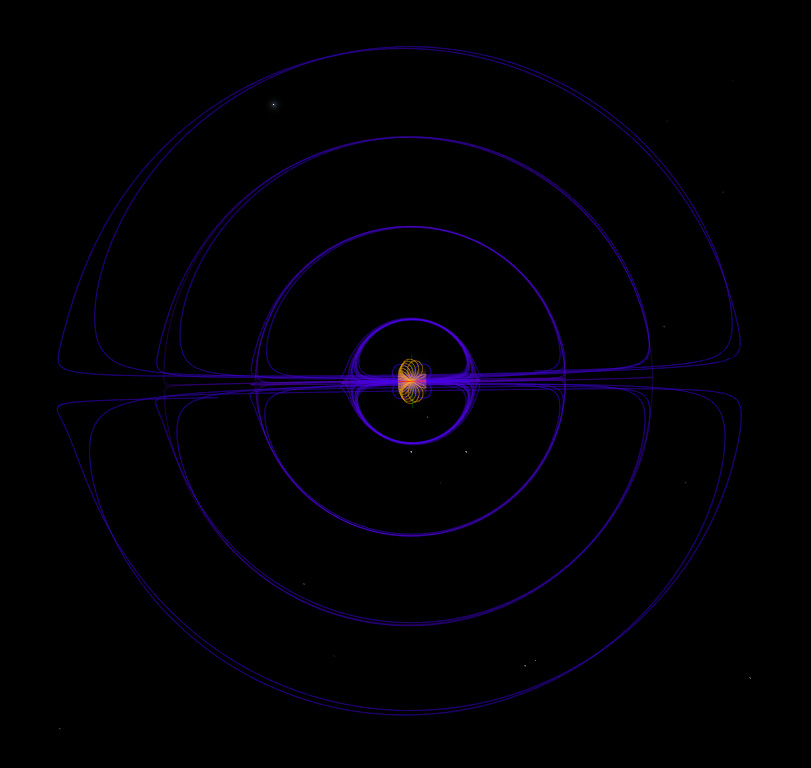
It's really strange that there's a spiral pattern in one plane (so a wave moving out) and "frosted circles" in the orthogonal plane, like standing waves. Those circles are really rotating like a rigid body.
Posted: 10.01.2007, 03:06
by Cham
I think I'm pushing this crap too far :

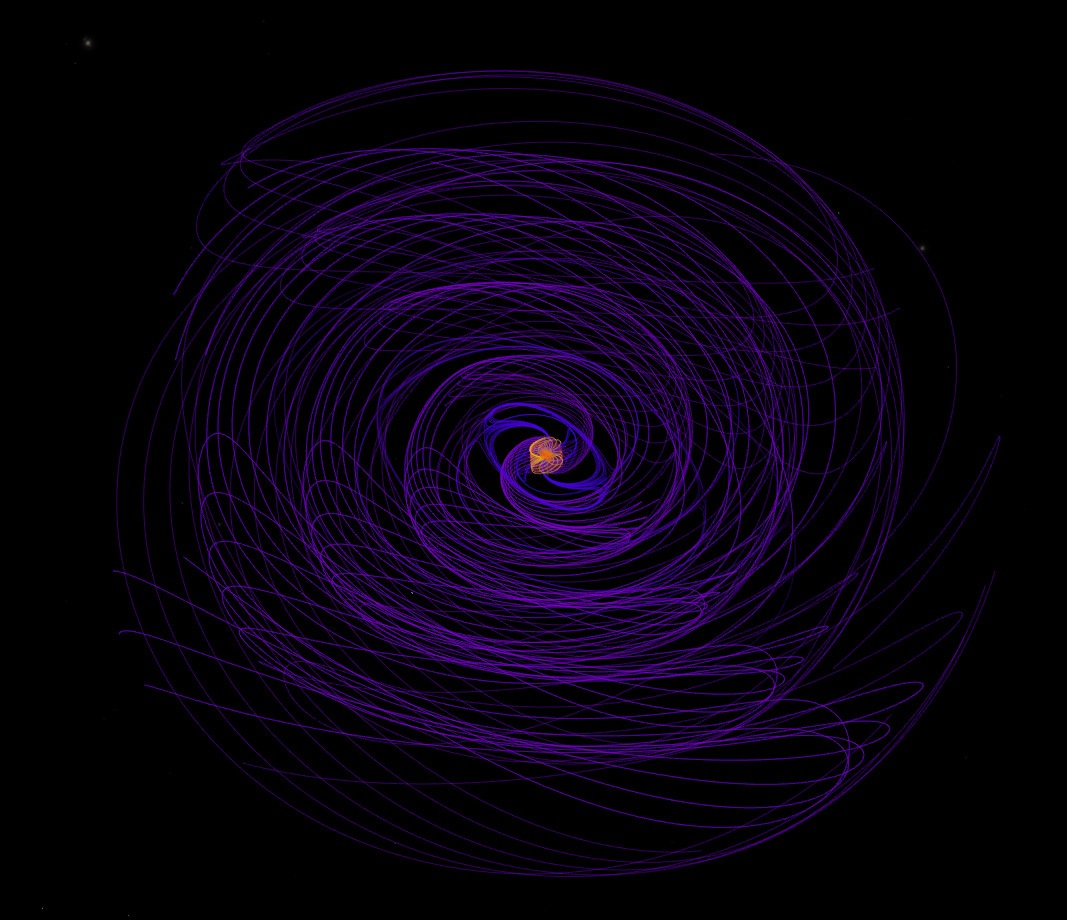
I'll forget those radiation layers. Too confused, and I'm starting to feel an impact on the frame rate, since there are so many VERY long field lines in there.
I still need to explore the other inclination angles (I'll experiment on alpha = 30?° and 45?°).
Posted: 10.01.2007, 03:40
by Cham
Here's a good compromise. Frame rate is perfect and the field isn't too confused. Click on the small pictures to get a large one :
